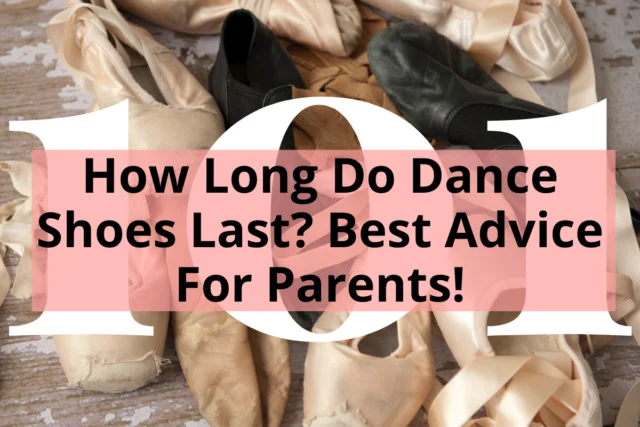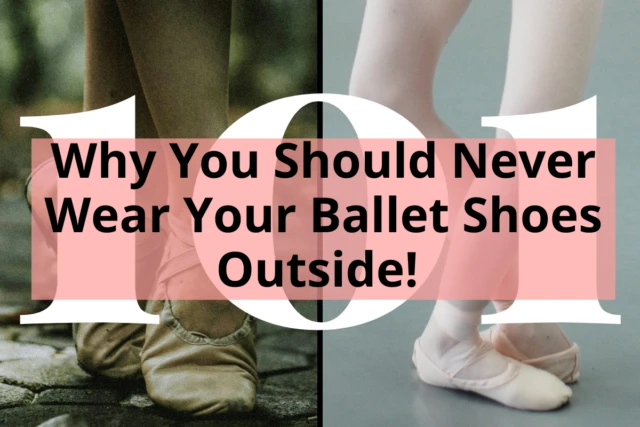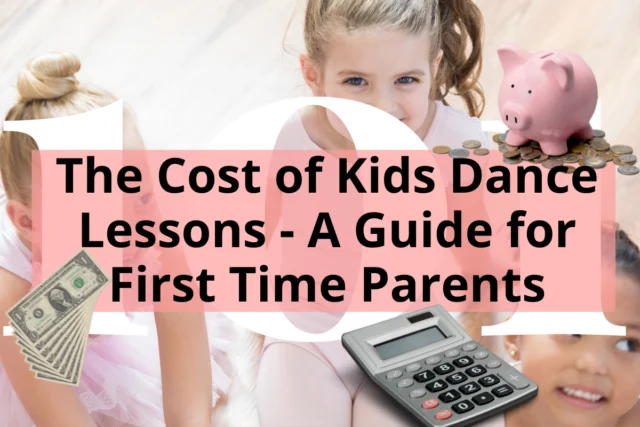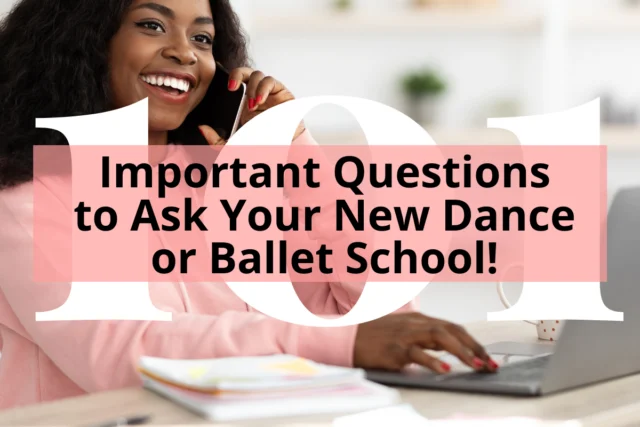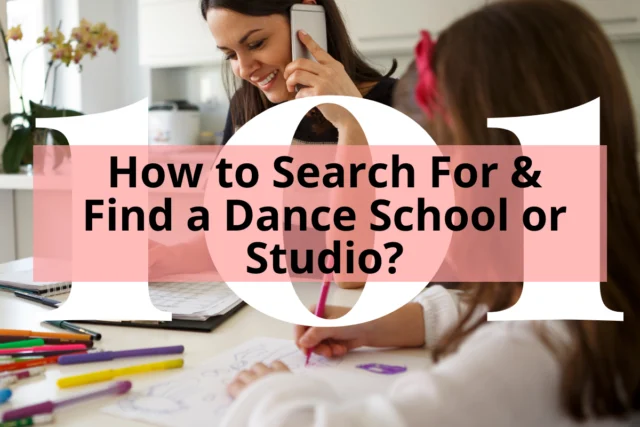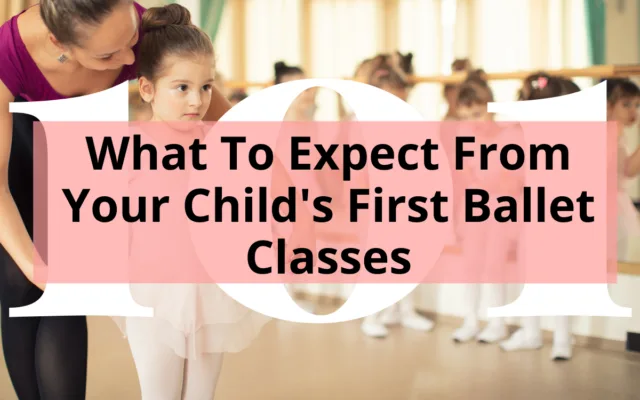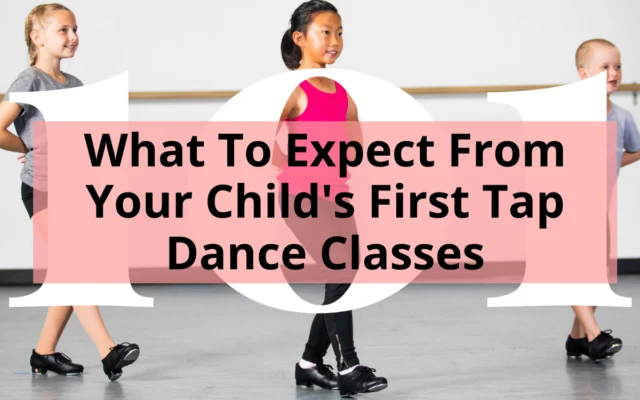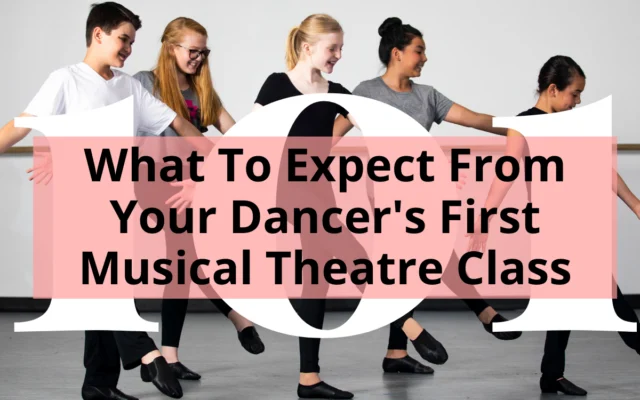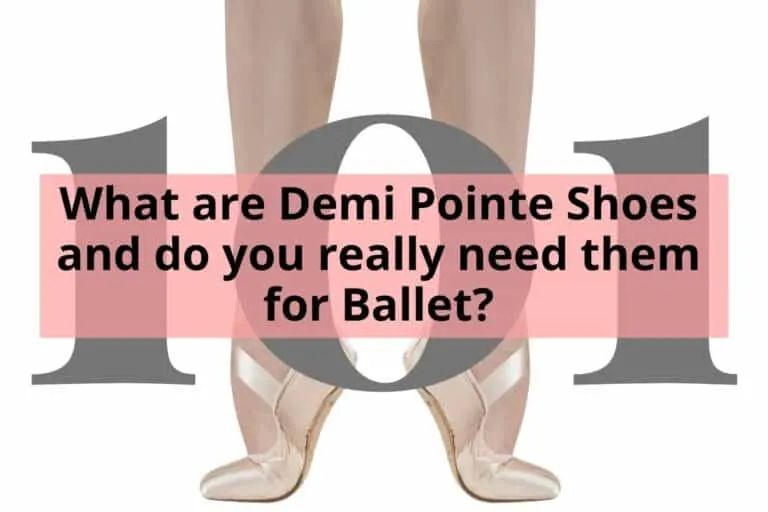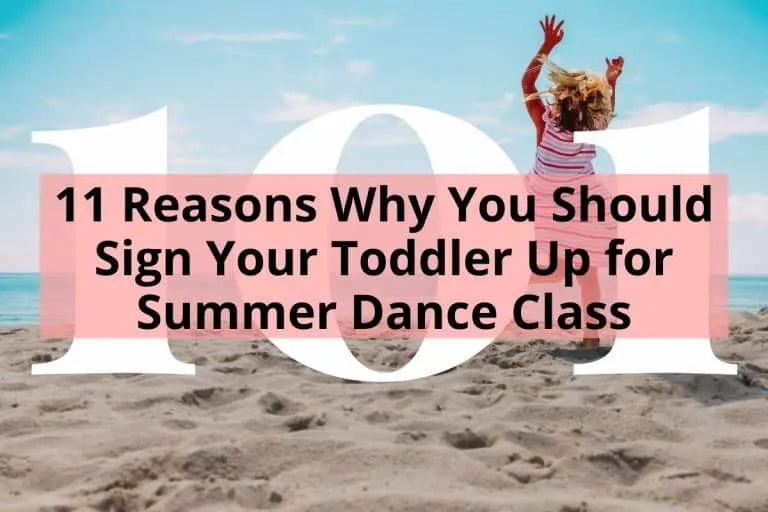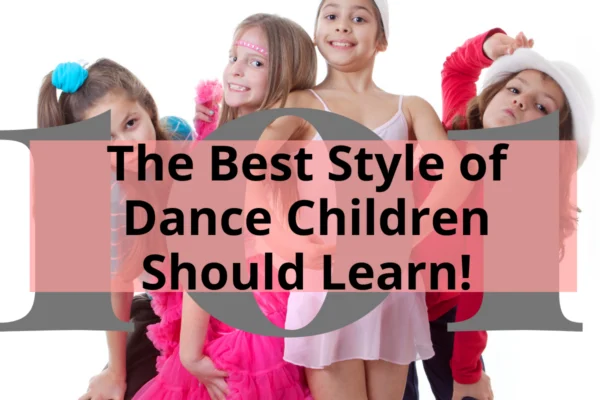Looking for a place to enroll your child in dance or ballet? Wanting a dance school that provides a safe, positive environment to learn and grow in but not sure what to actually look for to find that? How about a school that supports parents and is drama free?
Finding the right dance or ballet studio for your child and family can be a daunting task. But with the right information, it can also be an easy one!
Here are 18 things you can check out when looking for a dance studio!
- 1. REPUTABLE AND QUALIFIED TEACHERS
- 2. WHICH STYLES AND TYPES OF DANCE DO THEY OFFER?
- 3. CONCERTS, RECITALS, AND PERFORMANCES
- 4. SYLLABUSES AND CURRICULUMS
- 5. SCHOOL FOCUS – RECREATIONAL, PRE-PROFESSIONAL, OR COMPETITION SCHOOL
- 6. COMPETITIONS, SCHOOL DANCE COMPANIES, AND PERFORMANCE TEAMS
- 7. UNIFORMS AND EQUIPMENT
- 8. PERSONAL GROOMING/APPEARANCE POLICIES
- 9. HOW MANY STUDENTS ARE IN EACH CLASS?
- 10. LARGE SCHOOL OR SMALL SCHOOL
- 11. HOW INVOLVED ARE PARENTS IN THE DANCE SCHOOL?
- 12. FUNDRAISING OBLIGATIONS
- 13. CLASS & RECITAL MUSIC CHOICES
- 14. COMMUNICATION AND ORGANIZATION WITHIN THE SCHOOL
- 15. TUITION FEES AND OTHER COSTS
- 16. SCHEDULING, TIMING, AND LENGTH OF THE LESSONS
- 17. THE DANCE STUDIO FACILITIES
- 18. CONTRACTS, INSURANCE, AND EMERGENCIES
- CHOOSING YOUR SCHOOL
- Further Articles in this Series
- Other articles you may be interested in reading
1. REPUTABLE AND QUALIFIED TEACHERS

At the forefront of your list should be ensuring that the teachers at the studio are qualified to teach dance. Unfortunately, there are no universal dance teaching qualifications, in fact, it is possible for someone who has taken perhaps a year of lessons or less to simply open up a school – because dance studios are primarily businesses offering a service. So what are you looking for:
- a teaching certificate through a recognized dance curriculum or syllabus.
- A certificate, diploma, or associate diploma in dance, or dance teaching from a government accredited education facility.
- a Bachelor of Education from a university or college with a major or minor in Dance.
- a professional history of working as a dancer or choreographer which can be authenticated. Some teachers might have worked professionally for many years and be without an educational certificate but are extremely knowledgeable about the dance industry and can pass this experience on to their students.
- a history of working as a dance teacher or student teacher. Some teachers might have started teaching as a student at the dance school they learned from themselves that offered no curriculum or syllabus to follow. They were taught through experience. Others after dancing at a studio for many years upon graduating high school may have decided to open their own studios.
In all of these examples, it is essential to remember that you want to make sure any teacher you are taking your child to is aware of safe dance practices, first aid understands general work and safety laws gives age-appropriate dance lessons, and develops a positive and joyful experience for your child.
Depending on where you live, you might also want to ask about the staff’s working with children policies. In some countries, all people who work with children must have a police check or up-to-date working with children card. If you are choosing between two similar studios this might help you decide which studio is for you!
Top Tip
Make sure you find out if the experienced and qualified teacher of the studio will be actually be teaching your child.
Many studio owners who own large schools have teachers on staff to teach for them.
Also, be mindful that sometimes the teaching of beginner classes is also handed over to senior students of the school.
To become a teacher, students do need the experience of teaching, but young dancers pick up both good and poor technique in their training early on, and not all great dancers are great teachers.
2. WHICH STYLES AND TYPES OF DANCE DO THEY OFFER?
Many experts would agree that Ballet develops the foundations (strength, flexibility, and technique) for many other dance forms and if your child is serious about making dance their career then it is a no-brainer that they should be doing weekly ballet lessons.
But some children may not be ready for the discipline and patience that ballet takes.
They might lose their passion and joy for dance and quit before they really even start. Others might be wanting to learn the latest hip hop moves they have seen in various music videos and therefore ballet lessons will not be for them.
Finding lessons in a style that your child enjoys and commits to is the most important in beginning dance classes.
Adding on other styles after they learn to commit to their weekly training enhances their progress and ability is something you can always look into in the future.
You can read about this topic in-depth in our article ‘What Type of Dance Should My Child Learn?’
Top Tip
Some dance studios and schools may solely focus on one style of dance because that is the expertise of the teacher so it may or may not be right for your child. For example a ballet only school or an Irish Dance School.
Other schools may either be run by a teacher who is proficient in many disciplines such as ballet, jazz, tap, and acrobatics and offer all of these classes, or they may hire other teachers for the areas they are not so skilled in – this type of school will give you more options, but can mean over time more classes and time commitment and can be costly if your child wants to do them all!
3. CONCERTS, RECITALS, AND PERFORMANCES

Most parents are happy for their child to participate in some sort of annual performance to show off the learning and progress achieved by their child.
But the focus each dance studio places on these performances can be drastically different.
One school might end their year with an open class for family and friends to attend, another might produce a small collection of performances, performed within their studio or another location using minimal costuming and props.
At the other end of the spectrum, some schools produce both a half-yearly and end of year recital bonanzas, which are full-blown showcases with expensive costumes, full stage make-up props, and lighting in a theatre or other similar venue, with many rehearsals and dress rehearsals to perfect the performance.
Most dance schools today do something in between the above two extremes, but you should be finding out about what you are getting yourself and your child into before you pay your non-refundable enrolment fee!
Top Tip
You should find out when enrolling about the costs involved in a recital. Some schools offer recital packages where you pay a portion of the fee in installments throughout the year. What is included in this fee varies greatly between every school – for example, some include free tickets with this fee others do not!
4. SYLLABUSES AND CURRICULUMS
Some dance schools and studios, follow some type of syllabus or curriculum so you should ask and find out if the one you are thinking of signing up for does as well.
A dance curriculum is a learning structure that has been developed to advance a student’s skill, technique, and performance in some form of logical sequence.
Advancement involves a student’s capability to pass some sort of test or dance examination.
There are many different syllabuses all over the world with some of the most well-known being The Royal Academy of Dance, Cecchetti Ballet, Vaganova, CommDance, and BBO dance.
The final culmination of most curriculums and syllabus examinations results in students attaining their own teaching qualifications in that curriculum.
Exams usually do not commence until a child is of school age, therefore the newbie toddler or preschool dance parent may not be aware of what they are signing their child up for in the future.
Examinations also incur extra entry fees and sometimes require committing to a certain number of classes per week to ensure a student meets the requirements to pass the exam.
Top Tip
It is not a bad thing if a school does not follow a syllabus or curriculum, however, if they do not you might want to ask what kind of dance pedagogy or philosophy they follow if any.
5. SCHOOL FOCUS – RECREATIONAL, PRE-PROFESSIONAL, OR COMPETITION SCHOOL
Different dance teachers and schools will offer your child different opportunities in their studios based on their dance and teaching values, philosophies, and even business strategies.
I would like to first put a disclaimer on the following descriptions and say that a dance school can be a combination of any of the following! But defining schools in this way can help you think about what you want to find in a dance school that aligns with your own values.
Some dance schools focus on dance for recreation. They are not looking to develop the next Misty Copeland or Maddie Ziegler for instance. They want their students to learn in a relaxed and fun environment which means they are not competitive. They will generally have fewer lessons to attend per week and may put on annual recitals. This is not to say they cannot produce wonderful dancers who do become professionals, but that is not their top priority or goal, which is usually to provide accessible lessons for all their students.
Some dance schools are known for the many professional dancers that have attended their classes and slowly these schools become known as schools that focus on developing professional dancers. These schools are sometimes competitive but focus on technique classes and consistency so attending several classes a week to master the skills needed for a professional career.
Other dance schools have a large focus on creating performance opportunities for their dancers which usually includes attending competitions. The extent of competitiveness within the school will vary but in general, the kids and parents at these schools are very committed and love the whole process of preparing and performing for competitions.
Top Tip
It is probably not until your child turns 7-9 that you will start to find that the type of school you have chosen makes a difference to the trajectory of your child’s dance journey, so it is quite important to work out where the school’s focus is before you join them.
6. COMPETITIONS, SCHOOL DANCE COMPANIES, AND PERFORMANCE TEAMS
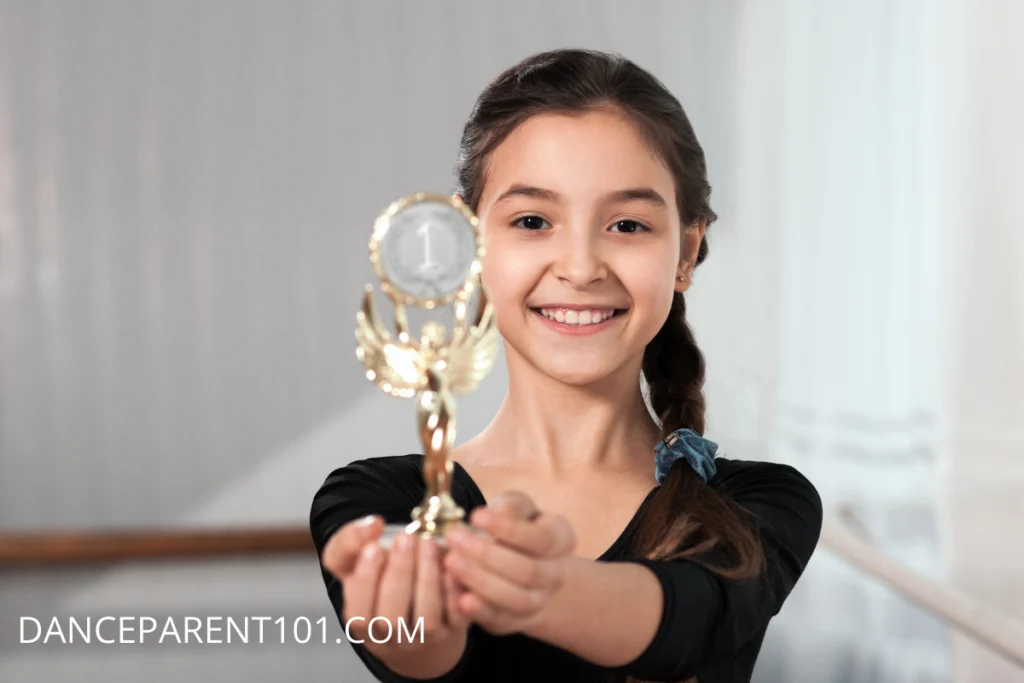
If from the last point you find out the school does competitions you need to find out the school’s involvement level in them!
Some studios place great importance on participation in dance competitions, and winning trophies for their studio. This can create a highly competitive environment and if not managed by the studio teachers, the drama between parents. (Most studio owners have policies that they enforce about parent drama so look out for one who is confident in dealing with parents!)
Most competitive schools require their students to audition for places in competition squads, performance teams, or the school company through a selection process and require those students to commit to rehearsal classes on top of normal technique lessons available.
Competitions do give dancers the opportunity to perfect their performance skills and when working in a group can develop great camaraderie, friendship, and teamwork among children.
The flip side is that they can be high pressure, and can raise unrealistic expectations and anxiety rather than joy and passion for dance. It can also mean that more time is spent on perfecting timing and unison of dance routines rather than working on developing strong technique, strength, and flexibility.
Most competition schools do not want to be known just as competitive schools and therefore they place a lot of emphasis on developing their student’s technique, which means your child will have to attend extra classes on top of their competition team commitments.
Competitive dance means extra time, money, and effort from all involved. More costumes, extra lessons, road trips, and weekends to neighboring towns and sometimes states are all part and parcel of the dance competition life.
If you are wondering what the difference is between a competition or performance team focused school and a dance school that centers its studies around the study of mainly Ballet and examinations for example you can read about that in our article ‘Which is Better? A Non-Competitive or Competitive dance school?
Top Tip
If the dance studio you choose does competitions and you have a child passionate about dance there is a high chance that you will end up doing them. Even if you enroll in the school initially thinking that you will choose to forgo those performance opportunities, your child will know the opportunity is there and will at some stage inevitably ask you for permission to do them, if the teacher doesn’t ask you first!
7. UNIFORMS AND EQUIPMENT
Most Dance studios today require after the first trial lessons, that you buy their school uniform from them for your child to wear during their classes. At a minimum, this will usually consist of a leotard and tights for girls and shorts/tights and a t-shirt for boys.
Some dance studios on the other hand might have a general outline or standard of the types of attire required.
In most cases, you will also have to buy specific shoes such as ballet or tap shoes which you can read about in our article Ultimate Guide To Choosing The Right Shoes For Dance Lessons!.
Many schools do have second-hand uniforms, shoes and other accessories available as students outgrow them or choose to follow different paths.
Uniform requirements are definitely a cash outlay situation that you need to consider when choosing a dance school.
Top Tip
Most dance school uniforms are not just leotards, they will possibly also include things like a tracksuit, a bag, a skirt, crop top, shorts, and more. Although dancewear is necessary, be on the lookout for schools that want you to kit out your child in their gear excessively as this is a revenue-building activity for some schools!
Also, your child may or may not have to purchase all of the items on a dance uniform list in their first year. For example, studio tracksuits are sometimes mainly used for attending performance events. If your child is not involved with these you may not need to get one straight away.
Get a uniform list before you enroll with the prices and ask your teacher which items they will definitely need.
8. PERSONAL GROOMING/APPEARANCE POLICIES

Some dance and ballet schools will expect their students to look neat and tidy at all times as they wish to uphold certain standards within their school. This might mean mastering stray hairs and Ballet buns and ensuring you have several pairs of ballet tights on hand in case of holes.
At the other end of the spectrum, there are also schools that want their students to express themselves freely and do not want to restrict creativity and therefore have a more relaxed approach to the dress and appearance of the students at their dance studio.
Top Tip
Watch how-to videos such as our tutorials How to do a Ballet Bun on Short Hair – Video and Photo Instructions and Everything you need to make the perfect ballet bun! for help on grooming for dance class.
9. HOW MANY STUDENTS ARE IN EACH CLASS?
Just as you might be concerned in a school classroom if there are too many children, you may want to find out just how large or small the school or the classes you are considering enrolling in are.
A large dance school may mean more students in one class or it might also mean the school is able to offer a few of the same classes over several days so classes are smaller. This way you can choose to enroll in the least busy session to ensure your child gets the adequate attention they need.
Top Tip
Many schools also have a cut-off points for their class sizes and you may be told a class is almost full. This is generally not a sales ploy to get you to sign up on the day, but an indication that you will need to make a decision sooner rather than later otherwise you may miss out.
10. LARGE SCHOOL OR SMALL SCHOOL
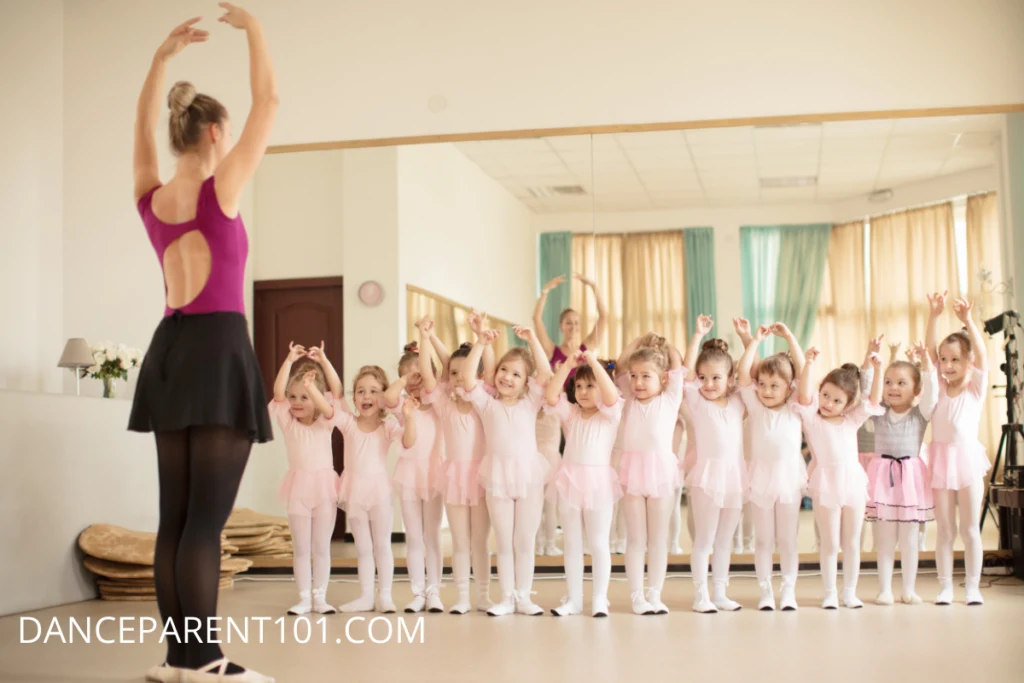
There are both pros and cons to attending a small or large dance studio so you should be looking at which you prefer, rather than thinking about which will produce a better dancer, because both can depend on the teachers!
| Cons of a Large Dance School | Pros of a Large Dance School |
|---|---|
| If a dance school is very large you might not be cared for as intimately as you might at a smaller school. | Larger studios might have resources that a smaller studio might lack. |
| Your child may be taught by a teacher with less experience than the studio owner or main teacher as beginner lessons are generally passed on to teachers with less experience. | Larger studios will have more people on staff to cover admin and other roles meaning that there is more than one adult on the premises and time is not taken up in class as might be, by the teacher who is running the whole business themselves. |
| As there are more teachers, there can be more variety of dance styles taught at the school | |
| Larger studios can offer more of the same classes so if you can’t make it on a Wednesday, there may be the same class on another day for you to enroll in. | |
| This might be a con for some, but going to a bigger school means there are more parents to help out with fundraising, prop and costume making, etc… so you may not need to help out as much. |
| Cons of a Small Dance School | Pros of a Small Dance School |
|---|---|
| If the one teacher does not teach a certain style of dance it will not be offered. | Smaller studios are usually run by one or two teachers so you only have access to the knowledge and resources they provide. |
| This might not be a con for some, but parent involvement might be required more often for fundraising, making props, and costumes as there are fewer parents and many jobs to still go around. | The teacher usually takes on many roles including admin, marketing, and more which can mean that they |
| Fewer classes are offered because there are fewer teachers. | |
| At a small dance school, everyone knows everyone else, and you aren’t as lost in the crowd. | |
| Your dancer’s needs are more often met because your teacher and studio owner knows you and your child well and can cater to them, which is harder at a large studio if too many different needs are required to be met. |
Top Tip
If given the choice between a large or small school narrow down your research to the teaching staff, as this will be one of the most important factors rather than the size of the school.
11. HOW INVOLVED ARE PARENTS IN THE DANCE SCHOOL?
Some dance studios will require parents to be very involved in the life of the dance school and may have a parents and friends group, whilst others will have a kiss and drop approach.
The involvement of parents can range from volunteering to make props, costumes, to usher at the recital, coming on a busy bee day to help pack up the costumes after the recital, or even helping clean the studio once a term.
Some studios pay staff to do all of these jobs rather than ask for parent volunteers, which is one reason fees can vary from school to school which I discuss in a point further below.
Some parents might also want to have some involvement in the instruction and learning of their child for example:
Is it important for you to speak with the dance class instructor after every class? Some studios may be quite busy with teachers requiring you to make appointments or a set time out of class to speak with them.
Do you want to offer advice and suggestions and be in the room whilst your child is dancing. This can sometimes be offered by very patient and cooperative teachers through private tuition, which can be costly.
Some studios also offer mummy and me classes which are a great way to introduce your child to dance and also get a feel for the teaching approach and dance studio in general.
Top Tip
The more staff a dance studio owner has, the higher your overall fees will be. But this usually means less of your time is needed as a volunteer for many tasks which can be a win win for some parents but not others!
12. FUNDRAISING OBLIGATIONS

You should be checking with a dance or ballet studio before enrolling to see if you are committing to help with fundraising efforts.
Many schools do fundraising to help with costs such as paying for professional lighting at their recital or being able to provide masterclasses for students or helping with travel costs for those attending competitions.
Some dance schools take on a mandatory approach to fundraising and ask all parents to sell something to friends and family such as boxes of greeting cards or even socks. I have also heard of one studio that makes the families of their dancers find up to $200 worth of business to advertise in their recital program.
Top Tip
Not all dance schools fundraise, and some only do if you join the competition or company team. But knowing your obligations about finance before committing is always wise.
13. CLASS & RECITAL MUSIC CHOICES
When visiting the school or if you are able to attend the studio’s annual performance or view the school’s choreography via social media, think about the music choices being made.
If your child is taking jazz or hip hop lessons are the music choices age appropriate and if not – are you comfortable with that.
Top Tip
Ask your teacher if they have a policy on the type of music they use in class and for performances. If they are casual and say they don’t always listen to the lyrics, they use music dependent on the beat and melody that you know that this is not as important to them as it is to you!
14. COMMUNICATION AND ORGANIZATION WITHIN THE SCHOOL
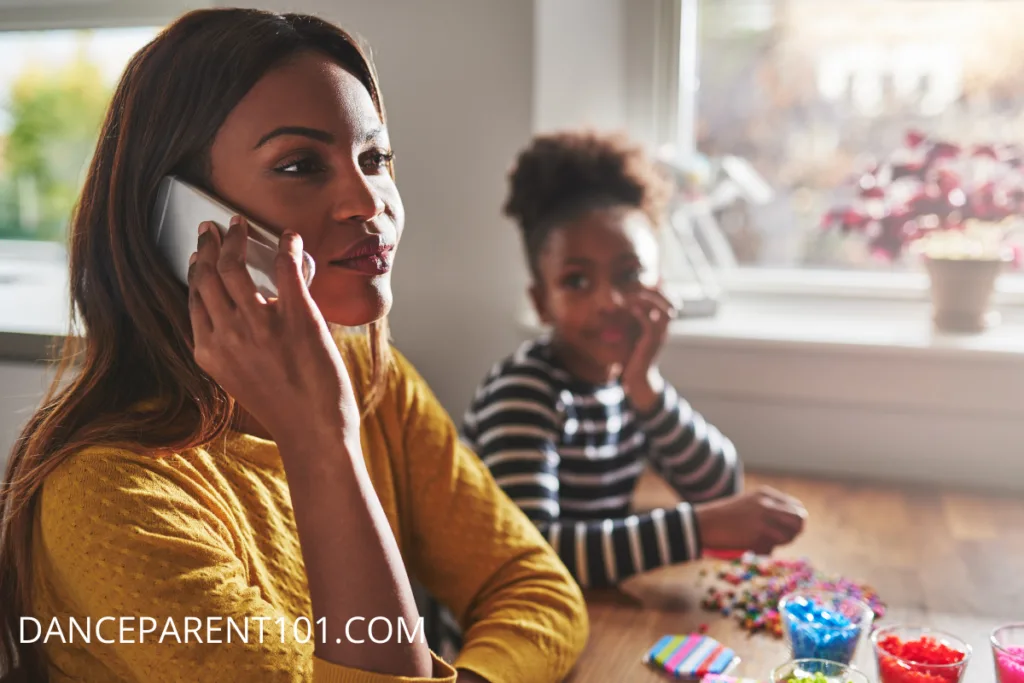
You should find out how a dance school communicates with their parents when enrolling at a dance school.
If the teacher gives you a vague answer or starts to tell you they are working hard on that this year and can’t really tell you the best way that happens, it probably means they have no consistent or organized way of communicating with their dancers and parents.
You will know if a dance teacher and studio is organized if they can already tell you important dates such as when recitals will be, that they produce a dance school newsletter and tell you how you receive that for example. Being handed a parent handbook or a link to one is also a good indication that the studio has policies that they stand by and enforce – especially if they require you to sign a form saying you have read them!
Top Tip
Don’t be fooled by a pretty website when enrolling in a dance school. This might have been created by an outside contractor and the photos used may not even be of the dance school. Therefore a good-looking website does not always mean you have a tech-savvy, organized dance teacher at the other end.
15. TUITION FEES AND OTHER COSTS
Ensure that a clear and transparent fee structure is available so that you know exactly how much you will be expected to pay for the year.
It should include all items you are expected to pay for such as term tuition fees, a dance uniform, costume hire for concerts, insurance, or an annual admin fee.
When looking at these costs, you will need to decide what costs you are actually willing or able to pay for in your child’s dance education.
Top Tip
Remember in the beginning dance lessons will be relatively cheaper than in the future. This is because when they are young or start out they will attend 1 or 2 classes a week and will only be in 1 or 2 items in their recital. This is compared to doing 5-10 or more classes a week and being in the same amount of items as they take on more classes and styles of dance.
Our article ‘How much do dance classes cost? We compare 50+ schools across the US!’ is a great resource!
16. SCHEDULING, TIMING, AND LENGTH OF THE LESSONS
Generally, if your child is under five, one lesson a week with a 30-45minute time frame will be enough. But as your child gets older the class length will extend as will the number of classes they do. For more information on this check out our article How Many Dance or Ballet Classes (Age & Class Guide).
But what you need to ask is does that lesson fit well into your schedule?
Do you have other children who nap or need to be dropped off at school or do you need to find lessons that work around your working hours?
If your child is older they might want to enroll in several dance styles or disciplines and depending on the school these classes may be clustered over one evening or spread over several days.
You will also need to think about how far away the dance school is from your home?
There may be a lot of driving to and from classes especially if your child wishes to take their initial hobby more seriously.
You will need to consider the cost this will have not only in the form of gas or petrol but also on whether the amount of time you and your child spend commuting will be worth it for a 30min or 1-hour lesson.
Something else to consider is the yearly timetable or schedule for lessons. Do lessons adhere to the school term or is your child expected to continue to attend lessons during school holidays?
Top Tip
Just because a school offers lots of classes or has longer classes does not mean the dance studio is better than a studio offering fewer or shorter lessons. Quality can be more important than quantity and your dancer will need rest days for their bodies to recuperate.
17. THE DANCE STUDIO FACILITIES
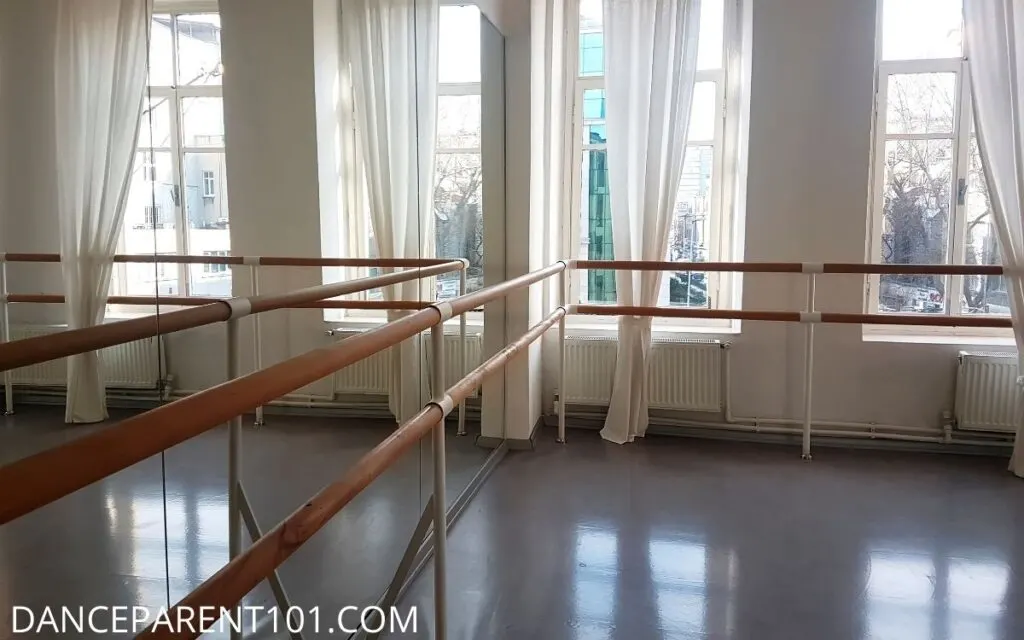
Before we even get into any special equipment you might be looking out for, be mindful of the location and environment of the dance studio.
Is it located on a busy street where parking is limited?
Is the street and building well lit (as your child gets older their lessons will be later in the evening)?
Is the building neat and tidy and free of any obstructions?
Is there easy and secure access for students to get to toilets and change rooms (as in many cases this will be done without supervision during lessons)?
Are the toilets clean and well supplied?
Is there a waiting room or space to wait inside the building?
Are there facilities to fill bottles with clean drinking water or even make a cup of tea?
Some of these things might be more or less important to you, but most importantly you are looking for information that tells you this is a safe place where you feel confident leaving your child.
Some important things you will want to make sure you are seeing in the actual dance studio might be:
- A large unobstructed area that allows several students to be in a lesson without trampling over each other.
- High ceiling clearance for lifts, jumps, or other tricks such as in acrobatics or cheerleading class.
- Full-length mirrors so that the dancers are able to see the line and placement of their bodies.
- Flooring that is smooth and free of splinters, nails, or other obstructions that might hurt a child rolling around the floor.
- Flooring needs from lesson to lesson may vary. A school that teaches only ballet and classical dance lessons should have sprung floors with a vinyl covering usually known as Dansflor, Tarkett or Marley. Whereas a school that teaches only tap dancing may have wooden floors to accentuate the tapping sound whilst dancing.
- A sturdy ballet barre.
Ballet Barres are not just for ballet and are good for the teaching of other lessons such as tap and jazz to perfect certain techniques and stretches. In saying that you might want to see if the studio perhaps offers adjustable barres for the height of little ones and if none are permanently attached to the walls are the moveable barres sturdy? Will your child have to help carry the barres to the center of the room and if so does your teacher, show students how to do this correctly as the stands, especially at each end, are very heavy.
Top Tip
So obviously a dance studio does need specific equipment, but in saying this, the school you are considering due to cost or locality may be run in a council hall or community center. Many teachers do run their dance schools very efficiently with little more than a large open space and a Bluetooth speaker.
18. CONTRACTS, INSURANCE, AND EMERGENCIES
Does your dance school have an insurance policy? As a business, the owner of the dance school should know it makes sense to insure themselves so they should have a public liability policy if so how does this exactly affect your child if they seriously hurt themselves during the dance class or even if you hurt yourself whilst on dance school property?
As a parent, I think it is also good to know if your dance teacher has a procedure for emergencies and do they have your phone number in a quick and easily accessible place if they needed to contact you quickly?
You might possibly also ask do you personally have or need insurance and does this policy cover your child’s extracurricular activities?
Top Tip
You will possibly have to sign a waiver or contract when you enroll that informs you of the studio insurance policy in that it will say what they a liable and not liable for. The studio will ask you to sign it as your child is participating in physical activity which will always have some risk of causing injury.
CHOOSING YOUR SCHOOL
Not everything on this list will be important to everyone, and I don’t expect you to print this out and take it to your prospective dance teacher or studio. But they are all things that you should in some way be looking into when searching for a dance or ballet studio for your child.
For more guidance on choosing a school – head to our article How to Choose the Best Dance School For Your Child: Guide For New Dance Parents
Further Articles in this Series
How to Choose the Best Dance School For Your Child: Guide For New Dance Parents
How to Search For & Find a Dance or Ballet School?
Important Questions to Ask Your New Dance or Ballet School!
Looking for a New Dance Studio? 4 Best Questions to Ask
15 Signs of a Bad Dance Teacher You Must Be Aware Of!



